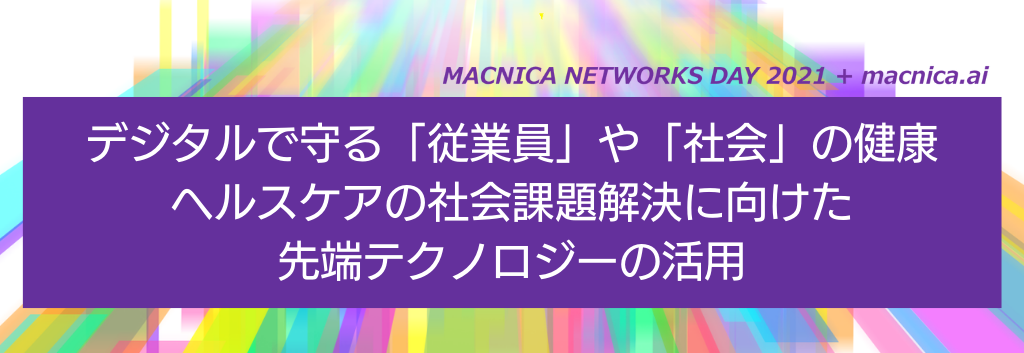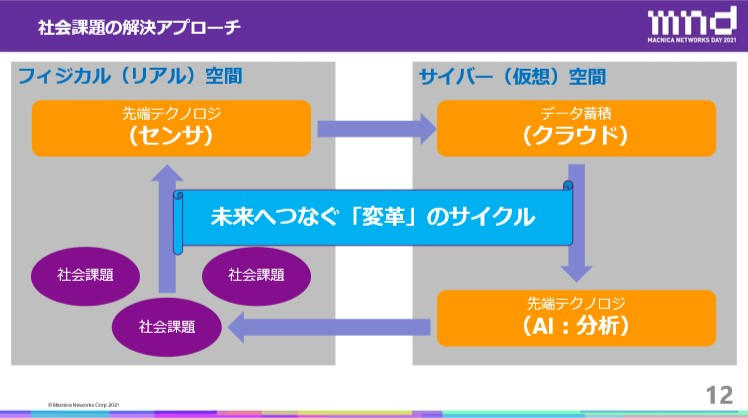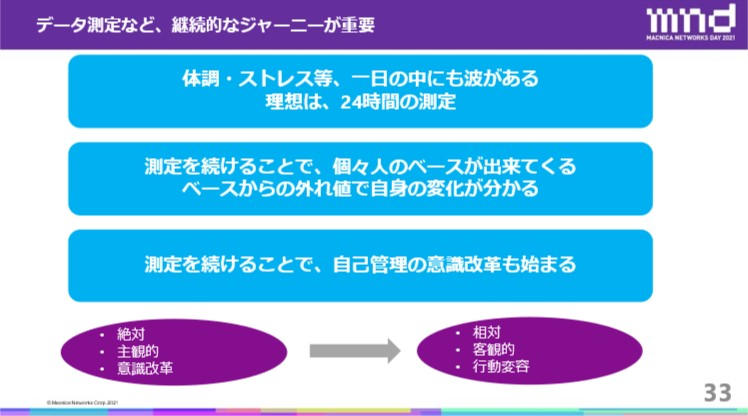
In the context of an ultra-aging society, social issues related to healthcare have become an important theme. In addition, the impact of the COVID-19 pandemic has created a need to address mental health and chronic diseases. Digital utilization is essential for business continuity and employee health promotion. Yasuto Kasahara of Macnica networks will introduce use cases on how to address healthcare issues using cutting-edge technology and data.
Solving social issues in the physical world digitally
Against the backdrop of population decline and aging, the use of DX in the healthcare field is accelerating. We are trying to solve social issues in physical (real) space using the power of digital. Data is acquired using sensors and stored in the cloud. The accumulated data is analyzed using AI, and the results obtained are used to solve social issues. At Macnica, we call this cycle the ``cycle of change that connects us to the future.''
"Labor shortages and an aging population can never be solved by 'ZaaS (Zangyo as a Service),' or unpaid overtime. The best way to solve social issues in the physical world is by using technology to create a cycle of change."栫)

By repeating the cycle of innovation, we will be able to accumulate not only data but also know-how and knowledge, which will enable us to solve social issues more efficiently.
Evolution of sensors makes it easier to acquire vital data
So, what kind of sensors are there that can be used in healthcare? For example, there is a solution that can acquire vital signs simply by taking a picture with a smartphone camera. By capturing a person's face, pulse information can be obtained from the reflection and color of the upper cheek. Vitals that can be measured include heart rate, respiration rate, blood oxygen level, and heart rate variability, and it is also possible to measure stress levels by multiplying heart rate variability with an algorithm. As a future roadmap, it will also be possible to measure estimated blood pressure and epidermal temperature.
Conventionally, to measure brain waves, it was necessary to capture the blood flow in the brain, or to capture electrical signals by inserting electrodes into the brain or using a large-scale magnetic sensor device. However, now there is an "EEG headset" that can measure brain waves simply by wearing a headset on the head. This makes it easier to perceive electrical signals emitted from the cerebral cortex as frequencies. The data that can be acquired include concentration, fatigue, interest, and interest. Furthermore, by processing the recognized images with AI, it is also possible to formalize and inherit the tacit knowledge of veterans.
There is a bed sensor as a sensor that is not attached. In addition to heart rate, breathing rate, sleep quality, you can measure body movements such as tossing and turning. It can also be used as a fall detection solution because it will notify you when you leave the bed.
There is also a solution that can easily acquire myoelectric data (muscle frequency) just by wearing pants-type myoelectric sensors. Conventionally, to measure myoelectricity, one had to shave one's body hair and attach electrodes, and measurement locations were limited to large-scale equipment such as shield rooms. However, the pant-type myoelectric sensor can obtain data for each muscle part and left-right balance of the lower body, and by adding a module to the abdomen, action data such as acceleration, direction change, distance, and jump can be obtained at the same time. will be
Technology that supports health management and CX improvement in various industries
As a solution that supports health management and improving customer experience (CX), healthcare technology is active in a variety of industries.
For example, technology is widely used in the trucking and transportation industry to manage driver health. According to a report by the Ministry of Land, Infrastructure, Transport and Tourism, the number of accidents caused by health conditions is on the rise. Previously, we conducted face-to-face roll calls to monitor the health status of drivers. IT roll calls have become popular after deregulation has allowed IT-based roll calls, and an increasing number of companies are now using portable breathalyzers linked to smartphones. Some companies have introduced measures to manage stress and sleep status by measuring vital signs.
``I believe that the future is near when we will be able to capture multiple vital signs using smartphones and use them for safety measures.'' (Kasumi)
Due to the effects of the coronavirus pandemic, face-to-face meetings have become mainstream, and we can imagine that non-face-to-face meetings will become the norm even after the coronavirus pandemic. The life insurance industry is similarly affected. In the current coronavirus pandemic, it is now possible to discuss contract details remotely using a web conferencing system. In the future, the health status required at the time of contract will no longer be based on declarations, but will be based on vital signs obtained using a smartphone. Furthermore, by providing an app that allows users to know their own health status and increasing customer contact points, it will be possible to improve services and create new CX.
In nursing care facilities for the elderly, the use of technology has accelerated due to revisions to nursing care fees. By meeting conditions such as installing monitoring devices such as bed sensors and intercoms, it became possible to reduce the number of staff required to be stationed at night. This will improve operational efficiency and will also improve profits as nursing care fees will be added.
Macnica provides bed sensors in packages. By using "Buddycom" provided by our partners, you can use your smartphone like an intercom. It also has the ability to transcribe and share audio data.
In the sports field, physical condition has traditionally been determined based on subjective judgments such as coaches' experience and intuition, or athletes' reports. Nowadays, GPS and sensors that measure heart rate make it possible to make objective decisions. In the future, by using real-time analysis using AI, it will be possible to determine when to stop training to reduce the risk of injury and create conditions that will allow you to perform on important match days. It will be.
"At Macnica, we provide the world's most cutting-edge solutions such as semiconductors and cybersecurity, and support the use of technology in a variety of industries.We have a large number of hardware specialists, so we can provide you with the world's most cutting-edge solutions such as semiconductors and cybersecurity. We can also make sensors.However, in order to run a cycle of solving social issues, we need customers and partners who can co-create with us, and we are also focusing on initiatives that will support us. Working on DX is difficult, but I hope that we can see it not as ``difficulty'' but as a path to ``big'' ``change,'' and tackle it with courage and ambition.'' (栫)

Finally, one of the keys to successful DX in the healthcare field can be said to be "continuous data acquisition." Vitals fluctuate throughout the day, and continuous data acquisition establishes an individual baseline. You can see changes in your physical condition from the vertical deviation from the baseline. In addition, continuous data acquisition raises awareness of self-management and encourages behavioral changes based on objective data, so it is one step closer to health management.
▼People caption
Macnica Networks Corp.
DX Business Department DX Business Department Manager
Yasuto Kashi
(as of July 2021)